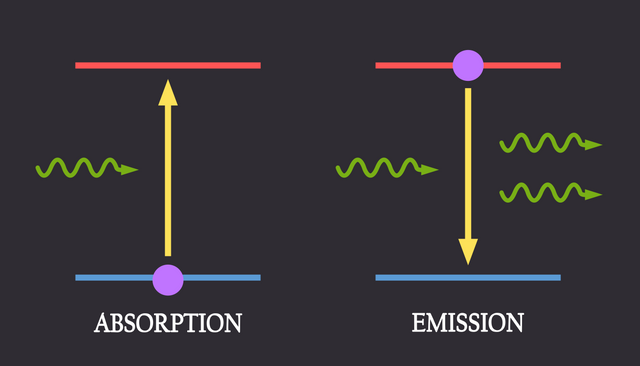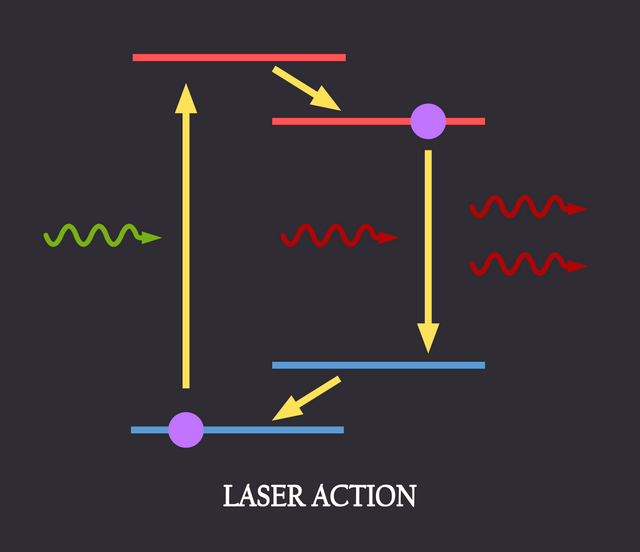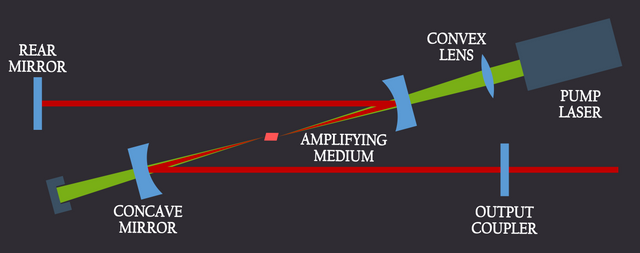I’m an Ultrafast Optics scientist, dealing everyday with shortest events ever created. Also, I’m a cryptocurrency enthusiast. Therefore, I thought, why shouldn’t I write about Ultrashort Laser Pulses to let more people know about this fascinating field of research and at the same time support content growth on steemit – our future social network overlords? I thought of a (rather long) series of (weekly or so) articles explaining this stuff. Going from basics of a solid-state laser emitting continuous light, through different pulse regimes, to the precise control of the shape of electric field of a femtosecond (10-15 s) pulse and even to attosecond (10-18 s) pulses – shortest events known to mankind. An attosecond to a second is like a second to the age of the universe! I have no idea how many of you (if any) will find this series interesting and how well I will manage to explain things (without equations!) – I will just try my best, and even if only one person will enjoy reading those, it will be worth it. Ok so let’s start from the start – How does the laser produce light?

Light is composed of photons. Indivisible portions of electromagnetic energy ranging from the radio waves through visible light to gamma rays. The only difference between a radio wave photon and a green light photon is its energy. Photons of all kinds are moving around and through us all the time, whether in a radio transmission, visible light emitted by street lights or from a cosmic gamma ray burst. Every photon has a wave-like attribute described by frequency and wavelength (both related to energy) which tells us how wavy it is. Photons can interfere, diffract, scatter, disperse, refract… those will be explained in future articles; but the most fundamental things that can be done with a photon is absorption and emission.

In this place usually are shown three diagrams, however I prefer to think about them as a perfectly symmetric two – as shown here. Both diagrams show two energy levels and a violet electron sitting on one of them. Electron can only have higher energy – red line, or lower energy – blue line. We often say that the electron is in the ground state (blue) or excited state (red). When a photon (green wiggly arrow) comes near an electron that sits in the ground state and it has energy matching the difference between the two levels it can be absorbed. After this interaction there will be no photon and the electron will gain energy as it is being promoted to the excited state. On the other hand, when a photon comes near an electron that is in the excited state already, it cannot be absorbed but it can force the electron to give away some of its energy in the form of a photon. A photon absolutely identical to the one that forced this transition. After this interaction there will be two identical photons and the electron will lose energy as it goes to the ground state. This is called stimulated emission. So, what am I saying is, light cannot be emitted when not stimulated by another photon? Yes, but in most cases this photon comes from a quantum vacuum, stimulates the emission and “goes back” to the vacuum. As this photon can come any time, from any angle and with any energy, this transition will take place randomly, giving a random photon on the output and the electron in the ground state. This is called spontaneous emission.

Stimulated emission is a key phenomenon to make the laser work. As it doubles the input photon it quickly could create plenty of them, all identical, all having the same energy, wavelength, frequency, direction in which they are moving, position in time and space and polarization (plane in which they wave). Important fact to remember is that for stimulated emission to occur not only we need a stimulating photon but also an electron that is in the excited state. Moreover, if we have more than one atom, and we better do if we want to make lots of photons, we need to make sure that more of them are in the excited state rather than ground state. Every electron in the ground state will destroy the photons we are creating. If there is more excited electrons than not, this state is called a population inversion. In this state material can create more electrons than it destroys and we have gain instead of loss for the photons going through it.

Picture above show the principles of a laser action. High energy green photon comes and is absorbed by the electron in the lowest energy level – promoting it to the highest one. From there, electron very quickly goes on a bit lower energy level without emitting any photons where it sits and waits for a red photon to come and stimulate the emission of a second red photon. Through this interaction electron falls onto the lower energy level and quickly to the lowest energy level possible, ready to be excited again by a green photon. Note that as the photon-less transitions are very fast, there will be always more electrons in the higher than in the lower state and laser action will be possible.

Ok, so we got a bunch of photons and electrons and we know how to make them create more photons. How do we do that efficiently? The most basic elements of a laser device are the amplifying medium, resonator mirrors and a source of energy. We will focus here on solid-state lasers, as they are most often used for creating ultrashort pulses. As the source of energy, we use a “pump” laser that emits green (higher energy) photons. Amplifying medium is the material containing electrons that can be excited and forced to emit red (lower energy) photons. And the resonator directs newly created photons back into the amplifying medium to create even more photons. How will we get the first red photon for the stimulated emission to take place if we don’t supply it from the outside? It will come randomly from the quantum vacuum and stimulate emission of our first own photon which then can force even more and more emissions.

Here is the most basic scheme of a laser setup. The energy in the form of green photons is pumped into the amplifier crystal through a lens from the pump laser and leftover, not absorbed light is blocked on the other side. Wait a minute, aren’t we making a laser that needs another laser to work? Yeah, but the role of a laser could be taken by a flash lamp, lasers are just much more efficient in doing that. And inside that green pump laser there is a tiny semiconductor laser that doesn’t need yet another laser or flash lamp to work – it is directly pumped by the electric current. Excited amplifier medium is placed between two concave mirrors that focus all red photons back into the amplifier to enhance stimulated emission. In principle we could use one of the concave mirrors as the laser output but I’ve drawn here a folded cavity so that we can insert in it more elements in the future more easily to get some pulse action out of it. So in this configuration there is also a rear mirror that reflects all red photons back on the concave mirrors for them to focus light on the amplifier, and an output coupler – a special mirror that leaks some of the incident light through. Because who needs a laser that has loads of photons inside but none are going outside? Nobody, and that’s a sad, sad laser.

So, to conclude, you now know how matter can absorb and emit photons and how to make a laser out of that. Making a well working laser is pretty hard and expensive but learning about it can be interesting and free. In the next article I will explain how to get pulses out of the laser through q-switching (microsecond and nanosecond pulses) and mode-locking (picosecond and femtosecond pulses). If you have any kind of questions about things discussed in the article or related to them, or if you have any other comments – feel free to ask them and I will answer.
@kabat, welcome and congratulations on making your first post! I gave you a $.05 vote! If you would be so kind to give me a follow in return, that would be most kind of you!!
Downvoting a post can decrease pending rewards and make it less visible. Common reasons:
Submit
Congratulations @kabat! You have completed some achievement on Steemit and have been rewarded with new badge(s) :
Click on any badge to view your own Board of Honor on SteemitBoard.
For more information about SteemitBoard, click here
If you no longer want to receive notifications, reply to this comment with the word
STOPDownvoting a post can decrease pending rewards and make it less visible. Common reasons:
Submit
Congratulations @kabat! You have completed some achievement on Steemit and have been rewarded with new badge(s) :
Click on any badge to view your own Board of Honor on SteemitBoard.
To support your work, I also upvoted your post!
For more information about SteemitBoard, click here
If you no longer want to receive notifications, reply to this comment with the word
STOPDownvoting a post can decrease pending rewards and make it less visible. Common reasons:
Submit
Congratulations @kabat! You received a personal award!
Click here to view your Board
Do not miss the last post from @steemitboard:
Vote for @Steemitboard as a witness and get one more award and increased upvotes!
Downvoting a post can decrease pending rewards and make it less visible. Common reasons:
Submit
Congratulations @kabat! You received a personal award!
You can view your badges on your Steem Board and compare to others on the Steem Ranking
Do not miss the last post from @steemitboard:
Vote for @Steemitboard as a witness to get one more award and increased upvotes!
Downvoting a post can decrease pending rewards and make it less visible. Common reasons:
Submit